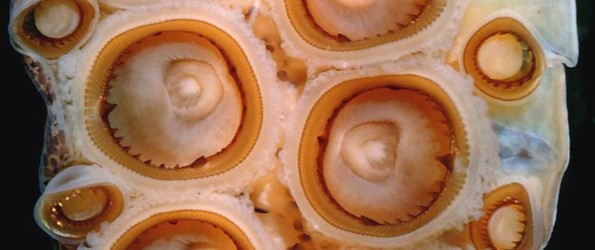- Arms
- Arm suckers in two series.
- Arm sucker number (male 240 mm ML) (Sasaki, 1929): Arm I - about 48; arms II, III - about 54; Arm IV - about 64.
- Arm suckers (Sasaki, 1929): Basal arm suckers teeth "... mostly triangular, numbering about 20;... [with] short plate-like supplementary teeth." Suckers in rows 3-10 with 24-28 teeth, "...bent crescentwise, sharply pointed, markedly unequal... ." Distal suckers with 9-12 teeth, ...slenderly conical, nearly uniform but sometimes minute supplementary teeth [present] ..."
- Tentacles
- Club with suckers in four series except at extreme base. Manus with about 10 transverse rows; dactylus with 20-29 transverse rows with dorsal series smaller than ventral series (Sasaki, 1929).
- Marginal manus suckers and dactylus suckers with 21-24 teeth (Sasaki, 1929).
 Click on an image to view larger version & data in a new window
Click on an image to view larger version & data in a new window
Figure. Oral view of the tentacular club of O. bartramii, 211 mm ML, Eastern Pacific off Southern California. Drawing from Young (1972).
- Photophores (Young, 1972). Numerous, small, closely packed integumental photophores of irregular shape embedded in ventral muscular tissue.
- Ventral mantle. Area dorsal to silvery stripe in skin with lower density of photophores. Area in midventral mantle posterior to silvery stripe lacks photophores. Concentration of photophores greatest near anterior margin of mantle and extend onto lateral sides of mantle. Dorsal photophores absent.
- Head. Irregular patch on either side of head where lateral funnel adductors attach to head. Small patch of photophores anterior to foveola. Irregular patch on head at base of each arm IV.
- Arms. Arm IV with long band of photogenic tissue all along arm within base of lateral keel.
- Funnel. Patch of photophores forming a V-shape dorsal to dorsal pad of funnel organ.
- Measurements
Sasaki, 1929 Sex Female Mantle length 415 Mantle width 104 Head length 75 Head width 89 Fin length 183 Fin width 300 Arm I, length 180 Arm II, length 200 Arm III, length 190 Arm IV, length 193 Club length 138 Largest sucker diameter, arm I 6 Largest sucker diameter, arm II 7 Largest sucker diameter, arm III 7 Largest sucker diameter, arm IV 6 Largest sucker diameter, club 9


Figure. Ventral view of O. bartramii, Eastern Pacific off Southern California, 210 mm ML, showing subcutaneous photophores. Drawing from Young (1972).







 Go to quick links
Go to quick search
Go to navigation for this section of the ToL site
Go to detailed links for the ToL site
Go to quick links
Go to quick search
Go to navigation for this section of the ToL site
Go to detailed links for the ToL site